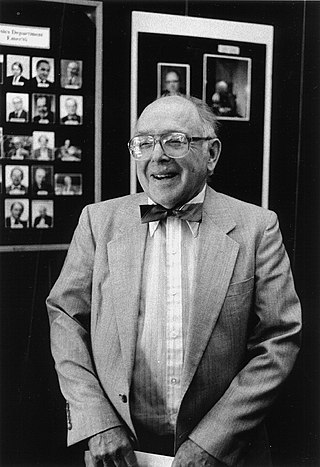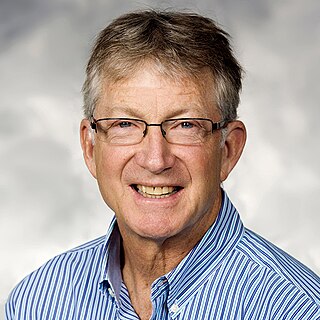Related Research Articles

John Bardeen was an American physicist and electrical engineer. He is the only person to be awarded the Nobel Prize in Physics twice: first in 1956 with William Shockley and Walter Brattain for the invention of the transistor; and again in 1972 with Leon N. Cooper and John Robert Schrieffer for a fundamental theory of conventional superconductivity known as the BCS theory.

Burton Richter was an American physicist. He led the Stanford Linear Accelerator Center (SLAC) team which co-discovered the J/ψ meson in 1974, alongside the Brookhaven National Laboratory (BNL) team led by Samuel Ting for which they won Nobel Prize for Physics in 1976. This discovery was part of the November Revolution of particle physics. He was the SLAC director from 1984 to 1999.

Joshua Lederberg, ForMemRS was an American molecular biologist known for his work in microbial genetics, artificial intelligence, and the United States space program. He was 33 years old when he won the 1958 Nobel Prize in Physiology or Medicine for discovering that bacteria can mate and exchange genes. He shared the prize with Edward Tatum and George Beadle, who won for their work with genetics.

Clifford Glenwood Shull was a Nobel Prize-winning American physicist.

Owen Kay Garriott was an American electrical engineer and NASA astronaut, who spent 60 days aboard the Skylab space station in 1973 during the Skylab 3 mission, and 10 days aboard Spacelab-1 on a Space Shuttle mission in 1983.
Bunji Sakita was a Japanese-American theoretical physicist who made important contributions in quantum field theory, superstring theory and discovered supersymmetry in 1971. He was a distinguished professor of physics at the City College of New York.
Charles Kittel was an American physicist. He was a professor at University of California, Berkeley from 1951 and was professor emeritus from 1978 until his death.
Akif Baha Balantekin is an American and Turkish physicist.
John Douglass Ferry was a Canadian-born American chemist and biochemist noted for development of surgical products from blood plasma and for studies of the chemistry of large molecules. Along with Williams and Landel, Ferry co-authored the work on time-temperature superposition in which the now famous WLF equation first appeared. The National Academy of Sciences called Ferry "a towering figure in polymer science". The University of Wisconsin said that he was "undoubtedly the most widely recognized research pioneer in the study of motional dynamics in macromolecular systems by viscoelastic techniques".
Keith Randolph Symon was an American physicist working in the fields of accelerator physics and plasma physics.

Charles H. Holbrow is an American physicist.
Cary B. Forest is professor of physics at the University of Wisconsin–Madison. His research relates to experimental plasma physics on the border between nuclear fusion research and laboratory plasma astrophysics. He is a fellow of the American Physical Society.
Malvin Avram Ruderman is an American physicist and astrophysicist.
James F. Gibbons is an American electrical engineer and academic administrator. He is credited with starting the semiconductor device fabrication laboratory at Stanford University that enabled the semiconductor industry and created Silicon Valley.

James L. Skinner is an American theoretical chemist. He is the Joseph O. and Elizabeth S. Hirschfelder Professor Emeritus at the University Wisconsin-Madison. He is also a member of the Scientific Advisory Board of the Welch Foundation. Most recently, Skinner was the Crown Family Professor of Molecular Engineering, professor of chemistry, director of the Water Research Initiative and deputy dean for faculty affairs of the Pritzker School of Molecular Engineering at the University of Chicago. Skinner is recognized for his contributions to the fields of theoretical chemistry, nonequilibrium statistical mechanics, linear and nonlinear spectroscopy of liquids, amorphous and crystalline solids, surfaces, proteins, and supercritical fluids. Skinner is the co-author of over 230 peer-reviewed research articles.
Charles Farwell Edson Jr. (1905–1988) was an American scholar of Ancient History.
Roy Walter Gould was an American electrical engineer and physicist who specialized in plasma physics. In 1959, he was the first to describe electrostatic waves that were propagating at the boundary of a magnetized plasma column, now commonly known as Trivelpiece–Gould modes.
Ivan Stephan Sokolnikoff was a Russian-American applied mathematician, who specialized in elasticity theory and wrote several mathematical textbooks for engineers and physicists.
Charles Elwood Mendenhall was an American physicist and professor at the University of Wisconsin–Madison.
Perry William Wilson was an American microbiologist and biochemist. He gained a scientific reputation as an outstanding pioneer in transforming the science of biological nitrogen fixation. His research helped to transform a mainly descriptive science into a more quantitative and analytic science based on biochemistry and statistical methods and control in bacteriology. He was called the "dean of biological nitrogen fixation".